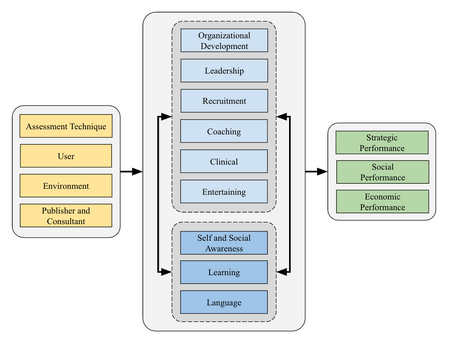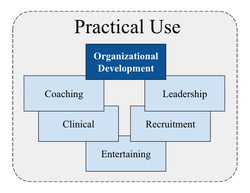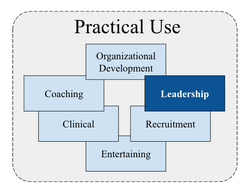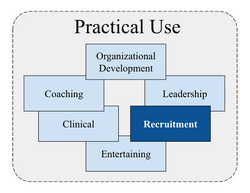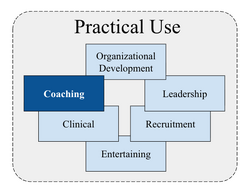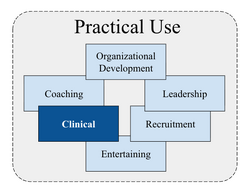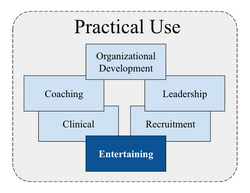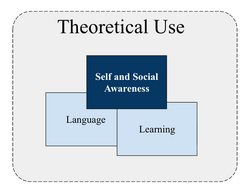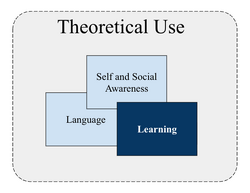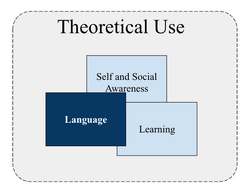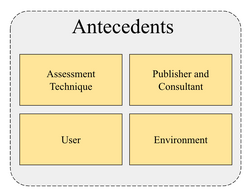Hypotheses Formulation: Difference between revisions
No edit summary |
mNo edit summary |
||
| (30 intermediate revisions by the same user not shown) | |||
| Line 1: | Line 1: | ||
[[File:GRI Model_detailed.png|right|450px]] | [[File:GRI Model_detailed.png|right|450px]] | ||
The hypotheses of the general framework | =Introduction= | ||
The hypotheses of the general framework have been formulated to answer the specific question on the relationship between the “Use of assessment techniques” and “Performance”. The operational content of the theoretical concepts "Use of assessment technique" was clarified during the analysis of the uses, which led to the consideration of nine categories. In this article, the hypothesis and how they were formulated are presented. | |||
=Formulation Criteria= | |||
Six primary uses of a practical nature have been identified. They are the uses in “Organizational Development”, “Leadership,” “Coaching,” “Recruitment,” “Clinical,” and “Entertaining.” Three uses of a theoretical nature have been identified: “Self and Social Awareness,” “Learning,” and “Language”. Of a more abstract nature, these three theoretical uses are present transversally in the six practical ones. | |||
To operationally define the relationship between the “Use of assessment techniques” and “Performance,” we say that there is agreement when, over time, performance increases, while the “Use of assessment techniques” increases too. Conversely, there is disagreement when the performance decreases or does not change, while the “Use of the assessment technique” increases. | To operationally define the relationship between the “Use of assessment techniques” and “Performance,” we say that there is agreement when, over time, performance increases, while the “Use of assessment techniques” increases too. Conversely, there is disagreement when the performance decreases or does not change, while the “Use of the assessment technique” increases. | ||
The confrontation between the concepts of “Use of assessment technique” constructed inductively and the literature (obtained deductively) forms provisional refutable and confirmable hypotheses to be tested<ref>Zaltman, G, Pinson, C., Angelmar, R. (1973). Metatheory and Consumer Research, New York, Holt, Rinehart and Wintson.</ref>. The hypotheses are formulated in such a way that they make it possible to account validly for the relationship between the “Use of assessment technique” and “Performance”. The formulation of hypotheses was made to satisfy the criteria of plausibility, verifiability, precision, generalization, and communicability<ref>Mace G, Pétry F. (2000). Guide d’élaboration d’un projet de recherche en science sociales. DeBoeck Université.<br/>The criteria of plausibility, verifiability, precision, generalization, and communicability [[Hypotheses_Criteria|are discussed in a separate note here.]]</ref>. | The confrontation between the concepts of “Use of assessment technique” constructed inductively and the literature (obtained deductively) forms provisional refutable and confirmable hypotheses to be tested<ref>Zaltman, G, Pinson, C., Angelmar, R. (1973). Metatheory and Consumer Research, New York, Holt, Rinehart and Wintson.</ref>. The hypotheses are formulated in such a way that they make it possible to account validly for the relationship between the “Use of assessment technique” and “Performance”. The formulation of hypotheses was made to satisfy the criteria of plausibility, verifiability, precision, generalization, and communicability<ref>Mace G, Pétry F. (2000). Guide d’élaboration d’un projet de recherche en science sociales. DeBoeck Université.<br/>The criteria of plausibility, verifiability, precision, generalization, and communicability [[Hypotheses_Criteria|are discussed in a separate note here.]]</ref>. | ||
=Use in Organizational Development= | =Use in Organizational Development= | ||
Among the various uses of assessment techniques, those at an organizational level appear to be the most significant and impactful. New information for analyzing teams, departments, companies, and their management during mergers, acquisitions, and reorganizations that is accurate helps make important decisions on people | [[File:PU Organization.png|right|250px]] | ||
Among the various uses of assessment techniques, those at an organizational level appear to be the most significant and impactful. New information for analyzing teams, departments, companies, and their management during mergers, acquisitions, and reorganizations that is accurate, helps make important decisions on people, which typically needs to happen fast, and will have important repercussions on their future development, engagement, and performance. | |||
Envisioning the jobs to be filled | Envisioning the jobs to be filled more accurately at all levels of a company, including for its executives and directors, is strategic for what the organization needs and how it will function. The characteristics of individuals who will be recruited and managed in those jobs will need to be consistent and align with the vision and strategic intent. This naturally happens with characteristics such as experience or diplomas. It happens similarly with other characteristics that can help in leveraging performance. | ||
In behavioral terms, | In behavioral terms, for comparisons with individuals’ adaptive profiles, we refer, at GRI, to those characteristics at a job level as a PBI (Position Behavior Indicator), or at a team or company level as a TBI (Team Behavior Indicator). The use of those indicators has proven valuable for guiding recruitment and organizational development by executives and managers. | ||
As research in Agent-Based Models (ABMs) shows<ref>Macy M. W., Willer R. (2002). From Factors to Actors: Computational Sociology and Agent-Based Modeling. Annual Review of Sociology, 28, 143-166.<br/>Axtell, Robert L., and J. Doyne Farmer. 2025. "Agent-Based Modeling in Economics and Finance: Past, Present, and Future." Journal of Economic Literature 63 (1): 197–287. DOI: 10.1257/jel.20221319</ref>, a better understanding of individual variables is necessary to analyze group phenomena and find effective, creative solutions. Given the importance of the relationships between macro and micro phenomena<ref>Alexander J. C., Giesen B., Münch R., Smelser N. (1987). The Micro-macro link. Berkeley and Los Angeles: University of California Press.</ref> and the capacity of assessment techniques to bring more objective quality information about people at these two levels, one can suppose that the use for organizational development has a strong and positive impact on performance. These observations make it possible to construct the following Hypothesis 1. | |||
'''Hypothesis 1''': The agreement between the use of the assessment technique and performance is more likely if the technique is used in organizational development. | '''Hypothesis 1''': The agreement between the use of the assessment technique and performance is more likely if the technique is used in organizational development. | ||
=Use in Leadership | =Use in Leadership= | ||
The following uses of the assessment technique fall into this category: employee motivation and engagement, day-to-day communication, management | [[File:PU Leadership.png|right|250px]] | ||
The following uses of the assessment technique fall into this category: employee motivation and engagement, inspiring a shared vision, day-to-day communication, people management, goal setting, feedback, periodic review, employee onboarding, management of meetings, and team members’ development<ref>The items mentioned are only examples; the list continues. As mentioned, it was inspired both deductively, by literature in leadership, and inductively, by observation from the exploration field.</ref>. Although some aspects may be handled by HR and team members, the responsibility of their execution falls to the leader. For leaders of leaders, leadership applies, to a minimum, to close team members. The ability to deal with conflicts and manage organizational change is an important part of this leadership category. | |||
The analysis of the effects | The analysis of the effects of assessment techniques clearly sets apart their uses in leadership from those that have traditionally been delegated to human resources, organizational development specialists, or coaches. The effects on leaders when using the information from the assessment on their own, and the effects for the organization, differentiate this category from those of recruitment, coaching and organizational development. | ||
Research by Kouzes and Posner on leadership clearly demonstrates the need for people and social skills in a leadership role, regardless of their style. A leader first needs social awareness and to find their strength before going out to take on some challenges; Among other things, they need to inspire a shared vision, enable others to act, and encourage the heart<ref>Kouzes, J. M., & Posner, B. Z. (2023). The leadership challenge: How to make extraordinary things happen in organizations (7th ed.). John Wiley & Sons.</ref>, which all call for people skills that | Research by Kouzes and Posner on leadership clearly demonstrates the need for people and social skills in a leadership role, regardless of their style. A leader first needs social awareness and to find their strength before going out to take on some challenges; Among other things, they need to inspire a shared vision, enable others to act, and encourage the heart<ref>Kouzes, J. M., & Posner, B. Z. (2023). The leadership challenge: How to make extraordinary things happen in organizations (7th ed.). John Wiley & Sons.</ref>, which all call for people skills that quality assessment techniques assist with. | ||
The importance of a leader’s personal characteristics and style: democratic, autocratic, participative, charismatic, etc., that of the people they lead, and the characteristics of the environment in which they operate have been covered by numerous studies on leadership and management<ref>See for instance: Bass B. M. (1990). Bass and Stogdill’s Handbook of Leadership: theory, research, and managerial application. New York: Free Press. | The importance of a leader’s personal characteristics and style: democratic, autocratic, participative, charismatic, etc., that of the people they lead, and the characteristics of the environment in which they operate have been covered by numerous studies on leadership and management<ref>See for instance: Bass B. M. (1990). Bass and Stogdill’s Handbook of Leadership: theory, research, and managerial application. New York: Free Press. | ||
</ref>. How relevant those characteristics are depends on the situation<ref>Hersey, P., Blanchard, K. H., Jhonson, D. E. (1996). Management of organizational behavior. Utilizing human resources. Prentice Hall. 6th Edition. First published in 1969.</ref> and thus the capacity to analyze the fit between the two, and for a leader to know how to adapt<ref>Vroom, V. H., Jago A. G. (2007). The Role of the Situation in Leadership. American Psychologist. Vol. 62, No. 1, p. 17-24.</ref>. More precise information from assessment techniques offers new insights and augments the capacity of a leader to build the leadership of their team members, and in return helps team members' leadership to build that of their leader<ref>Ibid, Bass B. M. (1990).</ref>. | </ref>. How relevant those characteristics are depends on the situation<ref>Hersey, P., Blanchard, K. H., Jhonson, D. E. (1996). Management of organizational behavior. Utilizing human resources. Prentice Hall. 6th Edition. First published in 1969.</ref> and thus the capacity to analyze the fit between the two, and for a leader to know how to adapt<ref>Vroom, V. H., Jago A. G. (2007). The Role of the Situation in Leadership. American Psychologist. Vol. 62, No. 1, p. 17-24.</ref>. More precise information from assessment techniques offers new insights and augments the capacity of a leader to build the leadership of their team members, and in return helps team members' leadership to build that of their leader<ref>Ibid, Bass B. M. (1990).</ref>. | ||
Other research provides evidence that a leader’s most complicated challenges are adaptive challenges that require people to adapt their behavior and change their values, beliefs, priorities, and loyalties<ref>Heifetz, R. A., Linsky, M., & Grashow, A. (2009). The practice of adaptive leadership: Tools and tactics for changing your organization and the world. Harvard Business Review Press.</ref>. Those, again, should benefit from more objective and accurate information on people’s development. | Other research provides evidence that a leader’s most complicated challenges are adaptive challenges that require people to adapt their behavior and change their values, beliefs, priorities, and loyalties<ref>Heifetz, R. A., Linsky, M., & Grashow, A. (2009). The practice of adaptive leadership: Tools and tactics for changing your organization and the world. Harvard Business Review Press.</ref>. Those, again, should benefit from more objective and accurate information on people’s development. All the above elements suggest that the link between the use of an assessment technique on leadership is fundamental and has a positive effect on performance. These observations make it possible to construct the following Hypothesis 2. | ||
All the above elements suggest that the link between the use of an assessment technique on leadership is fundamental and has a positive effect on performance. These observations make it possible to construct the following Hypothesis 2. | |||
'''Hypothesis 2''': The agreement between the use of the assessment technique and the performance is more likely if the technique is used in leadership. | '''Hypothesis 2''': The agreement between the use of the assessment technique and the performance is more likely if the technique is used in leadership. | ||
=Use in Recruitment= | =Use in Recruitment= | ||
“Recruitment” includes the process of selection, sourcing, search, interview, skills assessment, management of high potentials, succession planning, career development, promotion. In large organizations, these aspects are | [[File:PU Recruitment.png|right|250px]] | ||
“Recruitment” includes the process of selection, sourcing, search, interview, skills assessment, management of high potentials, succession planning, career development, and promotion<ref>As for leadership, the list for recruitment is not limited to those items. These are just examples. The list continues.</ref>. In large organizations, these aspects are managed by human resources departments. They are shared with leadership and managers who work closely with them. In smaller organizations, management takes a more active role, especially when the HR department focuses only on payroll and compliance. Unlike leadership, these aspects can all be outsourced and are increasingly supplemented by AI agents. | |||
Assessment techniques have | Assessment techniques have been used for mass recruitment since the early 20th century, for executive search since the 1980s, and similarly for promotions in large organizations. The use of mass recruitment has been the most studied in research, focusing on compliance with EEOC and ADA requirements, work-relatedness, and minimum reliability and validity. When these conditions are met, the assessment technique adds incremental value to other success factors, helping to improve individual and organizational performance. | ||
As | Additionally, when interviewing and making selection decisions, the interviewer can combine the information from the assessment technique with other subjective insights that need to be used immediately and are outside the scope of HR processes and AI automation. As observed at GRI, the results of the assessment technique are used during the recruitment stage to quickly help tailor the job to the candidate or, conversely, to help adapt the candidate to the job. The quality of the information, its relevance to the job, and the candidate’s behavioral adaptability are all crucial elements for making this decision. These observations lead to the formulation of the following Hypothesis 3. | ||
'''Hypothesis 3''': The agreement between the use of the assessment technique and the performance is more likely if the assessment technique is used in recruitment. | '''Hypothesis 3''': The agreement between the use of the assessment technique and the performance is more likely if the assessment technique is used in recruitment. | ||
=Use in Coaching= | =Use in Coaching= | ||
[[File:PU Coaching.png|right|250px]] | |||
Coaching has been on the rise since the late 1990s and has used assessment techniques early on, the most notorious one being the Myers-Briggs Typology Indicator or MBTI. Although the first phase of our research didn’t include this category in teh early 2000s, the evident use of assessment techniques in coaching and mentoring at all levels of an organization made them a natural candidate for the current revised framework. | Coaching has been on the rise since the late 1990s and has used assessment techniques early on, the most notorious one being the Myers-Briggs Typology Indicator or MBTI. Although the first phase of our research didn’t include this category in teh early 2000s, the evident use of assessment techniques in coaching and mentoring at all levels of an organization made them a natural candidate for the current revised framework. | ||
Assessment techniques used by coaches are numerous<ref>Möeller, H., and Kotte, S. (2022). “Assessment in coaching” in International handbook of evidence-based coaching: theory, research and practice. eds. S. Greif, H. Möller, W. Scholl, J. Passmore, and F. Müller (Cham: Springer International Publishing), 55–64.<br/>Passmore, J. (Ed.). (2012). Psychometrics in coaching: Using psychological and psychometric tools for development (2nd ed.). Kogan Page.</ref>, more recent than those in recruitment, but focused on individual personal development, team building, and other specific interventions such as conflict resolutions that are a natural continuation of a coaching service. Coaching is delivered typically remotely following a positive psychology or solution-focused format<ref>Sutton, J. (2020) Coaching styles explained: 4 different approaches. Psychology.com. https://positivepsychology.com/coaching-styles/</ref>. Techniques generally used by coaches include 360-degree feedback and personality assessments that are typologies (ie, Extroversion or Introversion), which characteristics differ from trait assessments used in recruitment. GRI’s factor approach is a distinct third category that we’ve also seen successfully used by coaches for | Assessment techniques used by coaches are numerous<ref>Möeller, H., and Kotte, S. (2022). “Assessment in coaching” in International handbook of evidence-based coaching: theory, research and practice. eds. S. Greif, H. Möller, W. Scholl, J. Passmore, and F. Müller (Cham: Springer International Publishing), 55–64.<br/>Passmore, J. (Ed.). (2012). Psychometrics in coaching: Using psychological and psychometric tools for development (2nd ed.). Kogan Page.</ref>, more recent than those in recruitment, but focused on individual personal development, team building, and other specific interventions such as conflict resolutions that are a natural continuation of a coaching service. Coaching is delivered typically remotely following a positive psychology or solution-focused format<ref>Sutton, J. (2020) Coaching styles explained: 4 different approaches. Psychology.com. https://positivepsychology.com/coaching-styles/</ref>. Techniques generally used by coaches include 360-degree feedback and personality assessments that are typologies (ie, Extroversion or Introversion), which characteristics differ from trait assessments used in recruitment. GRI’s factor approach is a distinct third category that we’ve also seen successfully used by coaches for developing self-efficacy. | ||
Coaching, however, is rarely involved with recruitment, which may be at the root of some challenges coaches are dealing with. It remains distinct from leadership development, as it focuses on personal development at work and in life rather than the organization being led and its outcome. Mentoring, which, rather than guiding leaders, provides them with experience, advice, and wisdom<ref> Passmore, J., & Tee, D. (2021). Coaching researched: A coaching psychology reader. John Wiley & Sons.</ref>, may use techniques, but more rarely so. | Coaching, however, is rarely involved with recruitment, which may be at the root of some challenges coaches are dealing with. It remains distinct from leadership development, as it focuses on personal development at work and in life rather than the organization being led and its outcome. Mentoring, which, rather than guiding leaders, provides them with experience, advice, and wisdom<ref> Passmore, J., & Tee, D. (2021). Coaching researched: A coaching psychology reader. John Wiley & Sons.</ref>, may use techniques, but more rarely so. | ||
| Line 65: | Line 60: | ||
=Use in Clinical Settings= | =Use in Clinical Settings= | ||
[[File:PU Clinical.png|right|250px]] | |||
Behavioral, mental health, occupational health, work-related stress, stress management, anxiety, depression, emotional exhaustion, burnout, physical health, and well-being services provided to employees, commonly referred to as the Employee Assistance Programs (EAP), are increasingly a standard part of corporate offerings to employees. Assessment techniques were devised and used for clinical practice in the late 1890s. They have been greatly refined over the years and continue to be used by clinicians to diagnose and provide therapy and counselling. | Behavioral, mental health, occupational health, work-related stress, stress management, anxiety, depression, emotional exhaustion, burnout, physical health, and well-being services provided to employees, commonly referred to as the Employee Assistance Programs (EAP), are increasingly a standard part of corporate offerings to employees. Assessment techniques were devised and used for clinical practice in the late 1890s. They have been greatly refined over the years and continue to be used by clinicians to diagnose and provide therapy and counselling. | ||
Use of health services has | Use of health services has significantly increased in companies since the pandemic, with new digital tools provided by mobile phones, video conferencing platforms, and, more recently, the support of AI agents. These services may sometimes include development and coaching on various topics, but because they focus on clinical therapy and counseling, they remain different from coaching. These services have consistently proven to be effective in helping to treat mental health issues, thereby improving work productivity<ref>Lyra (2025). State of Workforce Mental Health Report. A report from Mental Health Innovation Summit 2025. https://www.lyrahealth.com/resources/report/2025-state-of-workforce-mental-health-report/<br/>Kuang, T., Guo, C., Ren, M., Fu, L., Li, C., Ma, S., & Li, R. (2025). The effectiveness of e-mental health interventions on stress, anxiety, and depression symptoms in healthcare professionals: A systematic review and meta-analysis. BMC Public Health, 25(1), 1083. https://doi.org/10.1186/s13643-024-02565-6</ref>, and reducing a major inefficiency and expense in the modern economy.<ref>World Health Organization. (2024, September 2). Mental health at work. https://www.who.int/news-room/fact-sheets/detail/mental-health-at-work</ref>. | ||
</ref>, and | |||
We’ve observed at GRI psychiatrists and clinicians progressively using different assessment techniques than traditional ones, such as the Myers-Briggs | We’ve observed at GRI psychiatrists and clinicians progressively using different assessment techniques than traditional ones, such as the Myers-Briggs Type Indicator (MBTI) or the Enneagram. Those assessments have allowed them to get insights about their patients that were not available from traditional techniques, and were useful for diagnosing individual challenges, work-related issues, and counseling solutions. | ||
More nuanced information from assessment techniques, whether provided and used within or outside the organization by EAPs, should assist in improving mental health, removing systemic factors originating from the workplace, enhancing a person’s self-awareness, efficacy, and consequently the organization’s performance. These observations make it possible to construct the following Hypothesis 5: | More nuanced information from assessment techniques, whether provided and used within or outside the organization by EAPs, should assist in improving mental health, removing systemic factors originating from the workplace, enhancing a person’s self-awareness, efficacy, and consequently the organization’s performance. These observations make it possible to construct the following Hypothesis 5: | ||
| Line 76: | Line 71: | ||
=Use in Entertaining= | =Use in Entertaining= | ||
Assessment techniques literally measure any concept one may want to assess. They provide results, which, regardless of their quality, may impress many. They give the impression of carrying some truth, as numbers and statistics by the publisher show, regardless of the seriousness of those statistics. Does one like to know the kind of hero or genius they are? An application will provide the answer in no time. With AI, one can now quickly devise, test, and deploy new | [[File:PU Entertaining.png|right|250px]] | ||
Assessment techniques literally measure any concept one may want to assess. They provide results, which, regardless of their quality, may impress many. They give the impression of carrying some truth, as numbers and statistics by the publisher show, regardless of the seriousness of those statistics. Does one like to know the kind of hero or genius they are? An application will provide the answer in no time. With AI, one can now quickly devise, test, and deploy any new technique. | |||
The current revised framework includes three parallel assessment techniques: 1) Personal techniques, those of everyone, that are subjective and that statistics can never check; 2) Common techniques that companies may refer to for analyzing culture fit, and 3) Esoteric techniques that are as old as the beginning of time. Those assessments are all commonly used in organizations and compete with other assessment techniques. | The current revised framework includes three parallel assessment techniques: 1) Personal techniques, those of everyone, that are subjective and that statistics can never check; 2) Common techniques that companies may refer to for analyzing culture fit, and 3) Esoteric techniques that are as old as the beginning of time. Those assessments are all commonly used in organizations and compete with other assessment techniques. | ||
Assessment techniques | Assessment techniques continue to attract curiosity. Participants often ask: What might this other technique reveal about me? They remain popular in magazines, including astrology, although the Internet has helped bring the experience online with more interactivity, color, and faster results. They serve as a tool to entertain discussions, regardless of the technique's validity, reliability, or seriousness. In a large group presentation, answering an assessment technique helps jump-start conversations and increases participants' interest. | ||
Although | Although the entertaining effect can be easily observed, its connection to performance may be indirect, occurring alongside other uses. However, it is distinct from them and should be considered separately. These observations allow us to formulate the following Hypothesis 6: | ||
'''Hypothesis 6''': The agreement between the use of the assessment technique and the performance is more likely if the technique has an entertaining effect. | '''Hypothesis 6''': The agreement between the use of the assessment technique and the performance is more likely if the technique has an entertaining effect. | ||
=Use in Self and Social Awareness= | =Use in Self and Social Awareness= | ||
Assessment techniques are used in feedback sessions or | [[File:TU Awareness.png|right|250px]] | ||
Techniques greatly | Assessment techniques are used in feedback sessions or reports to provide participants with useful information for their personal growth. The information helps them identify their strengths, communication style, decision-making, career development, and more. | ||
Techniques vary greatly in how measures are taken, presented, and used. Their quality also differs. In any case, they act as indicators of self-awareness. Moreover, this information is shared with others to understand them more effectively and objectively. To different extents, this understanding links personal information to their role within the team and company. They help individuals feel positive about their own abilities and others' capacity to perform in unique ways. Discussions about knowledge of Self and Others are key in the social sciences. Philosophy, psychology, sociology, anthropology, and ethnology naturally have their say on the question. Self-awareness is at the heart of the personal development and self-discovery market, which reached $48 billion in 2024. | |||
Information from assessment techniques can potentially guide future growth, identify adaptive challenges, and create conditions for improving engagement. They also offer ways to resolve issues, prevent them from recurring, and stimulate continuous improvement. Consequently, using assessment techniques for self and social awareness supports their implementation in a large scope of practical applications at both the individual and group levels, while increasing their impact on performance. These insights lead to the formulation of the following Hypothesis 7: | |||
Information from assessment techniques can potentially | |||
'''Hypothesis 7''': The agreement between the use of the assessment technique and the performance is more likely if the technique improves self and social awareness. | '''Hypothesis 7''': The agreement between the use of the assessment technique and the performance is more likely if the technique improves self and social awareness. | ||
=Use in Learning= | =Use in Learning= | ||
The process of learning | [[File:PU Learning.png|right|250px]] | ||
Private techniques | The process of learning varies between assessment techniques. Online publishers require no training or certification from anyone. The responsibility for learning and accreditation lies with their clients. Publishers of assessments used in coaching require coaches to be certified; publishers of clinical assessments will only sell to accredited clinical psychologists. | ||
Private techniques clearly require no training because they are skills we have been practicing since birth. Common techniques are learned effortlessly through onboarding and by adopting the company’s culture. For esoteric techniques, the market is full of books and opportunities for further learning. The learning, whether light or deep, serves as the foundation for using the assessment technique. The type, depth, and number of applications learned and used depend on the capabilities of the technique. | |||
At GRI, we found that training is a crucial element for effectively using the adaptive profiles across their different applications, including leadership and organizational development. Unlike other models, the new assessment technique competes with leaders’ private techniques. For learning to occur, it needs to be relevant to their ongoing agenda, include real examples, foster interest in people, follow an impeccable process, and require a little time. | |||
In many cases, one-on-one coaching and mentoring have replaced group leadership training. However, interactions among managers during training group (T-group) sessions have demonstrated their value in knowledge acquisition. These sessions have utilized simple assessment techniques based on typology, similar to those used in coaching today. Research on sensitivity training<ref>Ibid, Bass B. M. (1990)</ref> has consistently shown the positive effects of training courses for leaders. When properly developed, the assessment technique adds value to leadership training and becomes a fundamental element. | |||
Learning skills with a new assessment technique develops over time through practice, similar to how it happens with cooking, sports, or playing a new musical instrument. The learning process is not instant. New skills are reinforced through their application, sharing with others, and improving them in real-world situations. The ability to continuously build on one's assessment skills increases its effectiveness in practical use and its impact on the organization’s performance. These points lead to the formulation of the following Hypothesis 8: | |||
Learning skills with a new assessment technique | |||
'''Hypothesis 8''': The agreement between the use of the assessment technique and the performance is more likely if its learning is nuanced and deep, rather than superficial, and continues over time. | '''Hypothesis 8''': The agreement between the use of the assessment technique and the performance is more likely if its learning is nuanced and deep, rather than superficial, and continues over time. | ||
=Use in Language= | =Use in Language= | ||
[[File:PU Language.png|right|250px]] | |||
Among the characteristics of assessment techniques, the language and signs created by the technique stand out as incommensurable, as the reading from the literature suggests<ref>Carnap, R. (1988). Meaning and Necessity. A study of Semantics and Modal Logic. The University of Chicago Press. 2nd Edition. First published in 1947.<br/>Quine, W. V. (1960). Word and Object. The MIT Press.<br/>Eco, U. (1979). A theory of Semiotics. Indiana University Press. Bloomington.<br/>Eco, U. (1988). Le Signe. Histoire et analyse d'un concept. Editions Labor. Translate from: Segno, 1973.<br/>Eco, U. (1995). The Search for the Perfect Language. Blackwell Publishers.<br/>Hacking, I. (2001). Probability and Inductive Logic. Cambridge University Press.<br/>Hacking, I. (2001). Why Language Matter To Philosophy? Cambridge University Press. 13th publication. First published in 1975.<br/>Korzybski, A. (1933). Science and Sanity. Institute of General Semantics.<br/>Hayakawa, S. I. (1939). Language in thought and action. Harcourt Brace Jovanovich.</ref>. | Among the characteristics of assessment techniques, the language and signs created by the technique stand out as incommensurable, as the reading from the literature suggests<ref>Carnap, R. (1988). Meaning and Necessity. A study of Semantics and Modal Logic. The University of Chicago Press. 2nd Edition. First published in 1947.<br/>Quine, W. V. (1960). Word and Object. The MIT Press.<br/>Eco, U. (1979). A theory of Semiotics. Indiana University Press. Bloomington.<br/>Eco, U. (1988). Le Signe. Histoire et analyse d'un concept. Editions Labor. Translate from: Segno, 1973.<br/>Eco, U. (1995). The Search for the Perfect Language. Blackwell Publishers.<br/>Hacking, I. (2001). Probability and Inductive Logic. Cambridge University Press.<br/>Hacking, I. (2001). Why Language Matter To Philosophy? Cambridge University Press. 13th publication. First published in 1975.<br/>Korzybski, A. (1933). Science and Sanity. Institute of General Semantics.<br/>Hayakawa, S. I. (1939). Language in thought and action. Harcourt Brace Jovanovich.</ref>. | ||
Mead’s work<ref>Mead G. H. (1934). Mind, Self and Society from the standpoint of a behaviorist. University of Chicago Press.</ref> | Mead’s work<ref>Mead G. H. (1934). Mind, Self, and Society from the standpoint of a behaviorist. University of Chicago Press.</ref> emphasizes the importance of signs in building a person and their connection to the system. Additionally, the functional role of signs has been most thoroughly analyzed by Pierce’s work<ref>Peirce, C. S. (1935) Philosophical Writings of Peirce. Selection of papers between 1931 and 1935 by J. S. Buchler New York, Dover Publications.</ref>, which focused on the symbol itself and its role in the inference process. From this perspective, the results of assessment techniques can be effective for quickly learning, memorizing, recalling, and creating new inferences and skills with other variables instantly. | ||
The results | The results from the assessment techniques have various qualities, including reports with short and long narratives, traits with numbers and scatter charts, typologies with words or letters like ESTJ for the Myers-Briggs Type Indicator, or D, I, S, C for the DISC system. With GRI, we chose profiles that can capture meaningful insights about people’s behaviors in the workplace, based on four factors. Four factors are enough to represent up to 90% of people’s behavior. | ||
Once learned, the symbolic language produced by the assessment technique is used to | Once learned, the symbolic language produced by the assessment technique is used to enhance knowledge, communication, and decision-making for both individuals and organizations. The more concise, nuanced, precise, memorable, and shareable the results are, the more they reduce communication ambiguity, improve decision-making, and contribute to enhancing other practical applications and their impact on performance. These observations allow for the formulation of the following Hypothesis 9: | ||
'''Hypothesis 9''': The agreement between the use of the assessment technique and the performance is more likely if the results and language created facilitate their practical use. | '''Hypothesis 9''': The agreement between the use of the assessment technique and the performance is more likely if the results and language created facilitate their practical use. | ||
=Causes of Use= | =Causes of Use= | ||
The analysis of the causal factors | [[File:Antecedents.png|right|250px]] | ||
The analysis of the causal factors allowed for identifying the antecedent variables that influence the use of assessment techniques: the properties of the “Assessment technique,” the qualities, role, and interests of “Individuals” using the technique, the organization, its culture, and the social “Environment” where the assessment technique is used, as well as the business model of the “Publisher and consultant.” | |||
The properties of the assessment technique and the publisher's business model are crucial factors that influence and precede their use. No concept measurement or result production is possible without the technique itself. Assessment techniques have different qualities that either limit or enable their use. The publisher and consultant's business model affects the autonomy, quality, and resources available for deployment. | |||
Not everyone is open to accepting that a new assessment method challenges their existing techniques or other approaches they already use. Each person and organization has their own beliefs about human nature, including how people and their organizations operate and why. These beliefs may change if prompted by their company or when confronted with practical results. Adaptive profiles of individuals and organizations can indicate how an assessment method will unfold, with varying levels of process, consensus, communication, and speed. The characteristics of the environment and the people evolve as the assessment method is implemented within the organization. These observations lead to the formulation of the following Hypothesis 10. | |||
Not everyone is | |||
'''Hypothesis 10''': The practical and theoretical use of the assessment technique is all the more probable if the assessment technique, publisher, environment, and individual user have appropriate characteristics. | '''Hypothesis 10''': The practical and theoretical use of the assessment technique is all the more probable if the assessment technique, publisher, environment, and individual user have appropriate characteristics. | ||
Latest revision as of 22:47, 23 September 2025
Introduction
The hypotheses of the general framework have been formulated to answer the specific question on the relationship between the “Use of assessment techniques” and “Performance”. The operational content of the theoretical concepts "Use of assessment technique" was clarified during the analysis of the uses, which led to the consideration of nine categories. In this article, the hypothesis and how they were formulated are presented.
Formulation Criteria
Six primary uses of a practical nature have been identified. They are the uses in “Organizational Development”, “Leadership,” “Coaching,” “Recruitment,” “Clinical,” and “Entertaining.” Three uses of a theoretical nature have been identified: “Self and Social Awareness,” “Learning,” and “Language”. Of a more abstract nature, these three theoretical uses are present transversally in the six practical ones.
To operationally define the relationship between the “Use of assessment techniques” and “Performance,” we say that there is agreement when, over time, performance increases, while the “Use of assessment techniques” increases too. Conversely, there is disagreement when the performance decreases or does not change, while the “Use of the assessment technique” increases.
The confrontation between the concepts of “Use of assessment technique” constructed inductively and the literature (obtained deductively) forms provisional refutable and confirmable hypotheses to be tested[1]. The hypotheses are formulated in such a way that they make it possible to account validly for the relationship between the “Use of assessment technique” and “Performance”. The formulation of hypotheses was made to satisfy the criteria of plausibility, verifiability, precision, generalization, and communicability[2].
Use in Organizational Development
Among the various uses of assessment techniques, those at an organizational level appear to be the most significant and impactful. New information for analyzing teams, departments, companies, and their management during mergers, acquisitions, and reorganizations that is accurate, helps make important decisions on people, which typically needs to happen fast, and will have important repercussions on their future development, engagement, and performance.
Envisioning the jobs to be filled more accurately at all levels of a company, including for its executives and directors, is strategic for what the organization needs and how it will function. The characteristics of individuals who will be recruited and managed in those jobs will need to be consistent and align with the vision and strategic intent. This naturally happens with characteristics such as experience or diplomas. It happens similarly with other characteristics that can help in leveraging performance.
In behavioral terms, for comparisons with individuals’ adaptive profiles, we refer, at GRI, to those characteristics at a job level as a PBI (Position Behavior Indicator), or at a team or company level as a TBI (Team Behavior Indicator). The use of those indicators has proven valuable for guiding recruitment and organizational development by executives and managers.
As research in Agent-Based Models (ABMs) shows[3], a better understanding of individual variables is necessary to analyze group phenomena and find effective, creative solutions. Given the importance of the relationships between macro and micro phenomena[4] and the capacity of assessment techniques to bring more objective quality information about people at these two levels, one can suppose that the use for organizational development has a strong and positive impact on performance. These observations make it possible to construct the following Hypothesis 1.
Hypothesis 1: The agreement between the use of the assessment technique and performance is more likely if the technique is used in organizational development.
Use in Leadership
The following uses of the assessment technique fall into this category: employee motivation and engagement, inspiring a shared vision, day-to-day communication, people management, goal setting, feedback, periodic review, employee onboarding, management of meetings, and team members’ development[5]. Although some aspects may be handled by HR and team members, the responsibility of their execution falls to the leader. For leaders of leaders, leadership applies, to a minimum, to close team members. The ability to deal with conflicts and manage organizational change is an important part of this leadership category.
The analysis of the effects of assessment techniques clearly sets apart their uses in leadership from those that have traditionally been delegated to human resources, organizational development specialists, or coaches. The effects on leaders when using the information from the assessment on their own, and the effects for the organization, differentiate this category from those of recruitment, coaching and organizational development.
Research by Kouzes and Posner on leadership clearly demonstrates the need for people and social skills in a leadership role, regardless of their style. A leader first needs social awareness and to find their strength before going out to take on some challenges; Among other things, they need to inspire a shared vision, enable others to act, and encourage the heart[6], which all call for people skills that quality assessment techniques assist with.
The importance of a leader’s personal characteristics and style: democratic, autocratic, participative, charismatic, etc., that of the people they lead, and the characteristics of the environment in which they operate have been covered by numerous studies on leadership and management[7]. How relevant those characteristics are depends on the situation[8] and thus the capacity to analyze the fit between the two, and for a leader to know how to adapt[9]. More precise information from assessment techniques offers new insights and augments the capacity of a leader to build the leadership of their team members, and in return helps team members' leadership to build that of their leader[10].
Other research provides evidence that a leader’s most complicated challenges are adaptive challenges that require people to adapt their behavior and change their values, beliefs, priorities, and loyalties[11]. Those, again, should benefit from more objective and accurate information on people’s development. All the above elements suggest that the link between the use of an assessment technique on leadership is fundamental and has a positive effect on performance. These observations make it possible to construct the following Hypothesis 2.
Hypothesis 2: The agreement between the use of the assessment technique and the performance is more likely if the technique is used in leadership.
Use in Recruitment
“Recruitment” includes the process of selection, sourcing, search, interview, skills assessment, management of high potentials, succession planning, career development, and promotion[12]. In large organizations, these aspects are managed by human resources departments. They are shared with leadership and managers who work closely with them. In smaller organizations, management takes a more active role, especially when the HR department focuses only on payroll and compliance. Unlike leadership, these aspects can all be outsourced and are increasingly supplemented by AI agents.
Assessment techniques have been used for mass recruitment since the early 20th century, for executive search since the 1980s, and similarly for promotions in large organizations. The use of mass recruitment has been the most studied in research, focusing on compliance with EEOC and ADA requirements, work-relatedness, and minimum reliability and validity. When these conditions are met, the assessment technique adds incremental value to other success factors, helping to improve individual and organizational performance.
Additionally, when interviewing and making selection decisions, the interviewer can combine the information from the assessment technique with other subjective insights that need to be used immediately and are outside the scope of HR processes and AI automation. As observed at GRI, the results of the assessment technique are used during the recruitment stage to quickly help tailor the job to the candidate or, conversely, to help adapt the candidate to the job. The quality of the information, its relevance to the job, and the candidate’s behavioral adaptability are all crucial elements for making this decision. These observations lead to the formulation of the following Hypothesis 3.
Hypothesis 3: The agreement between the use of the assessment technique and the performance is more likely if the assessment technique is used in recruitment.
Use in Coaching
Coaching has been on the rise since the late 1990s and has used assessment techniques early on, the most notorious one being the Myers-Briggs Typology Indicator or MBTI. Although the first phase of our research didn’t include this category in teh early 2000s, the evident use of assessment techniques in coaching and mentoring at all levels of an organization made them a natural candidate for the current revised framework.
Assessment techniques used by coaches are numerous[13], more recent than those in recruitment, but focused on individual personal development, team building, and other specific interventions such as conflict resolutions that are a natural continuation of a coaching service. Coaching is delivered typically remotely following a positive psychology or solution-focused format[14]. Techniques generally used by coaches include 360-degree feedback and personality assessments that are typologies (ie, Extroversion or Introversion), which characteristics differ from trait assessments used in recruitment. GRI’s factor approach is a distinct third category that we’ve also seen successfully used by coaches for developing self-efficacy.
Coaching, however, is rarely involved with recruitment, which may be at the root of some challenges coaches are dealing with. It remains distinct from leadership development, as it focuses on personal development at work and in life rather than the organization being led and its outcome. Mentoring, which, rather than guiding leaders, provides them with experience, advice, and wisdom[15], may use techniques, but more rarely so.
The primary impact of coaching and mentoring, as far as the use of assessment techniques may help, is the enhancement of self-efficacy, with self and social awareness—another independent variable of the present framework—happening concomitantly. Studies have consistently evidenced moderately positive effects on individual-level outcomes and personal efficacy[16]. Although not being the focus, the repercussions of increased self-efficacy may subsequently impact an organization’s performance. For this reason, the following Hypothesis 4 was constructed:
Hypothesis 4: The agreement between the use of the assessment technique and the performance is more likely if the technique is used in coaching.
Use in Clinical Settings
Behavioral, mental health, occupational health, work-related stress, stress management, anxiety, depression, emotional exhaustion, burnout, physical health, and well-being services provided to employees, commonly referred to as the Employee Assistance Programs (EAP), are increasingly a standard part of corporate offerings to employees. Assessment techniques were devised and used for clinical practice in the late 1890s. They have been greatly refined over the years and continue to be used by clinicians to diagnose and provide therapy and counselling.
Use of health services has significantly increased in companies since the pandemic, with new digital tools provided by mobile phones, video conferencing platforms, and, more recently, the support of AI agents. These services may sometimes include development and coaching on various topics, but because they focus on clinical therapy and counseling, they remain different from coaching. These services have consistently proven to be effective in helping to treat mental health issues, thereby improving work productivity[17], and reducing a major inefficiency and expense in the modern economy.[18].
We’ve observed at GRI psychiatrists and clinicians progressively using different assessment techniques than traditional ones, such as the Myers-Briggs Type Indicator (MBTI) or the Enneagram. Those assessments have allowed them to get insights about their patients that were not available from traditional techniques, and were useful for diagnosing individual challenges, work-related issues, and counseling solutions. More nuanced information from assessment techniques, whether provided and used within or outside the organization by EAPs, should assist in improving mental health, removing systemic factors originating from the workplace, enhancing a person’s self-awareness, efficacy, and consequently the organization’s performance. These observations make it possible to construct the following Hypothesis 5:
Hypothesis 5: The agreement between the use of the assessment technique and the performance is more likely if the technique is used in clinical settings.
Use in Entertaining
Assessment techniques literally measure any concept one may want to assess. They provide results, which, regardless of their quality, may impress many. They give the impression of carrying some truth, as numbers and statistics by the publisher show, regardless of the seriousness of those statistics. Does one like to know the kind of hero or genius they are? An application will provide the answer in no time. With AI, one can now quickly devise, test, and deploy any new technique.
The current revised framework includes three parallel assessment techniques: 1) Personal techniques, those of everyone, that are subjective and that statistics can never check; 2) Common techniques that companies may refer to for analyzing culture fit, and 3) Esoteric techniques that are as old as the beginning of time. Those assessments are all commonly used in organizations and compete with other assessment techniques.
Assessment techniques continue to attract curiosity. Participants often ask: What might this other technique reveal about me? They remain popular in magazines, including astrology, although the Internet has helped bring the experience online with more interactivity, color, and faster results. They serve as a tool to entertain discussions, regardless of the technique's validity, reliability, or seriousness. In a large group presentation, answering an assessment technique helps jump-start conversations and increases participants' interest.
Although the entertaining effect can be easily observed, its connection to performance may be indirect, occurring alongside other uses. However, it is distinct from them and should be considered separately. These observations allow us to formulate the following Hypothesis 6:
Hypothesis 6: The agreement between the use of the assessment technique and the performance is more likely if the technique has an entertaining effect.
Use in Self and Social Awareness
Assessment techniques are used in feedback sessions or reports to provide participants with useful information for their personal growth. The information helps them identify their strengths, communication style, decision-making, career development, and more.
Techniques vary greatly in how measures are taken, presented, and used. Their quality also differs. In any case, they act as indicators of self-awareness. Moreover, this information is shared with others to understand them more effectively and objectively. To different extents, this understanding links personal information to their role within the team and company. They help individuals feel positive about their own abilities and others' capacity to perform in unique ways. Discussions about knowledge of Self and Others are key in the social sciences. Philosophy, psychology, sociology, anthropology, and ethnology naturally have their say on the question. Self-awareness is at the heart of the personal development and self-discovery market, which reached $48 billion in 2024.
Information from assessment techniques can potentially guide future growth, identify adaptive challenges, and create conditions for improving engagement. They also offer ways to resolve issues, prevent them from recurring, and stimulate continuous improvement. Consequently, using assessment techniques for self and social awareness supports their implementation in a large scope of practical applications at both the individual and group levels, while increasing their impact on performance. These insights lead to the formulation of the following Hypothesis 7:
Hypothesis 7: The agreement between the use of the assessment technique and the performance is more likely if the technique improves self and social awareness.
Use in Learning
The process of learning varies between assessment techniques. Online publishers require no training or certification from anyone. The responsibility for learning and accreditation lies with their clients. Publishers of assessments used in coaching require coaches to be certified; publishers of clinical assessments will only sell to accredited clinical psychologists.
Private techniques clearly require no training because they are skills we have been practicing since birth. Common techniques are learned effortlessly through onboarding and by adopting the company’s culture. For esoteric techniques, the market is full of books and opportunities for further learning. The learning, whether light or deep, serves as the foundation for using the assessment technique. The type, depth, and number of applications learned and used depend on the capabilities of the technique.
At GRI, we found that training is a crucial element for effectively using the adaptive profiles across their different applications, including leadership and organizational development. Unlike other models, the new assessment technique competes with leaders’ private techniques. For learning to occur, it needs to be relevant to their ongoing agenda, include real examples, foster interest in people, follow an impeccable process, and require a little time.
In many cases, one-on-one coaching and mentoring have replaced group leadership training. However, interactions among managers during training group (T-group) sessions have demonstrated their value in knowledge acquisition. These sessions have utilized simple assessment techniques based on typology, similar to those used in coaching today. Research on sensitivity training[19] has consistently shown the positive effects of training courses for leaders. When properly developed, the assessment technique adds value to leadership training and becomes a fundamental element.
Learning skills with a new assessment technique develops over time through practice, similar to how it happens with cooking, sports, or playing a new musical instrument. The learning process is not instant. New skills are reinforced through their application, sharing with others, and improving them in real-world situations. The ability to continuously build on one's assessment skills increases its effectiveness in practical use and its impact on the organization’s performance. These points lead to the formulation of the following Hypothesis 8:
Hypothesis 8: The agreement between the use of the assessment technique and the performance is more likely if its learning is nuanced and deep, rather than superficial, and continues over time.
Use in Language
Among the characteristics of assessment techniques, the language and signs created by the technique stand out as incommensurable, as the reading from the literature suggests[20].
Mead’s work[21] emphasizes the importance of signs in building a person and their connection to the system. Additionally, the functional role of signs has been most thoroughly analyzed by Pierce’s work[22], which focused on the symbol itself and its role in the inference process. From this perspective, the results of assessment techniques can be effective for quickly learning, memorizing, recalling, and creating new inferences and skills with other variables instantly.
The results from the assessment techniques have various qualities, including reports with short and long narratives, traits with numbers and scatter charts, typologies with words or letters like ESTJ for the Myers-Briggs Type Indicator, or D, I, S, C for the DISC system. With GRI, we chose profiles that can capture meaningful insights about people’s behaviors in the workplace, based on four factors. Four factors are enough to represent up to 90% of people’s behavior.
Once learned, the symbolic language produced by the assessment technique is used to enhance knowledge, communication, and decision-making for both individuals and organizations. The more concise, nuanced, precise, memorable, and shareable the results are, the more they reduce communication ambiguity, improve decision-making, and contribute to enhancing other practical applications and their impact on performance. These observations allow for the formulation of the following Hypothesis 9:
Hypothesis 9: The agreement between the use of the assessment technique and the performance is more likely if the results and language created facilitate their practical use.
Causes of Use
The analysis of the causal factors allowed for identifying the antecedent variables that influence the use of assessment techniques: the properties of the “Assessment technique,” the qualities, role, and interests of “Individuals” using the technique, the organization, its culture, and the social “Environment” where the assessment technique is used, as well as the business model of the “Publisher and consultant.”
The properties of the assessment technique and the publisher's business model are crucial factors that influence and precede their use. No concept measurement or result production is possible without the technique itself. Assessment techniques have different qualities that either limit or enable their use. The publisher and consultant's business model affects the autonomy, quality, and resources available for deployment.
Not everyone is open to accepting that a new assessment method challenges their existing techniques or other approaches they already use. Each person and organization has their own beliefs about human nature, including how people and their organizations operate and why. These beliefs may change if prompted by their company or when confronted with practical results. Adaptive profiles of individuals and organizations can indicate how an assessment method will unfold, with varying levels of process, consensus, communication, and speed. The characteristics of the environment and the people evolve as the assessment method is implemented within the organization. These observations lead to the formulation of the following Hypothesis 10.
Hypothesis 10: The practical and theoretical use of the assessment technique is all the more probable if the assessment technique, publisher, environment, and individual user have appropriate characteristics.
Notes
- ↑ Zaltman, G, Pinson, C., Angelmar, R. (1973). Metatheory and Consumer Research, New York, Holt, Rinehart and Wintson.
- ↑ Mace G, Pétry F. (2000). Guide d’élaboration d’un projet de recherche en science sociales. DeBoeck Université.
The criteria of plausibility, verifiability, precision, generalization, and communicability are discussed in a separate note here. - ↑ Macy M. W., Willer R. (2002). From Factors to Actors: Computational Sociology and Agent-Based Modeling. Annual Review of Sociology, 28, 143-166.
Axtell, Robert L., and J. Doyne Farmer. 2025. "Agent-Based Modeling in Economics and Finance: Past, Present, and Future." Journal of Economic Literature 63 (1): 197–287. DOI: 10.1257/jel.20221319 - ↑ Alexander J. C., Giesen B., Münch R., Smelser N. (1987). The Micro-macro link. Berkeley and Los Angeles: University of California Press.
- ↑ The items mentioned are only examples; the list continues. As mentioned, it was inspired both deductively, by literature in leadership, and inductively, by observation from the exploration field.
- ↑ Kouzes, J. M., & Posner, B. Z. (2023). The leadership challenge: How to make extraordinary things happen in organizations (7th ed.). John Wiley & Sons.
- ↑ See for instance: Bass B. M. (1990). Bass and Stogdill’s Handbook of Leadership: theory, research, and managerial application. New York: Free Press.
- ↑ Hersey, P., Blanchard, K. H., Jhonson, D. E. (1996). Management of organizational behavior. Utilizing human resources. Prentice Hall. 6th Edition. First published in 1969.
- ↑ Vroom, V. H., Jago A. G. (2007). The Role of the Situation in Leadership. American Psychologist. Vol. 62, No. 1, p. 17-24.
- ↑ Ibid, Bass B. M. (1990).
- ↑ Heifetz, R. A., Linsky, M., & Grashow, A. (2009). The practice of adaptive leadership: Tools and tactics for changing your organization and the world. Harvard Business Review Press.
- ↑ As for leadership, the list for recruitment is not limited to those items. These are just examples. The list continues.
- ↑ Möeller, H., and Kotte, S. (2022). “Assessment in coaching” in International handbook of evidence-based coaching: theory, research and practice. eds. S. Greif, H. Möller, W. Scholl, J. Passmore, and F. Müller (Cham: Springer International Publishing), 55–64.
Passmore, J. (Ed.). (2012). Psychometrics in coaching: Using psychological and psychometric tools for development (2nd ed.). Kogan Page. - ↑ Sutton, J. (2020) Coaching styles explained: 4 different approaches. Psychology.com. https://positivepsychology.com/coaching-styles/
- ↑ Passmore, J., & Tee, D. (2021). Coaching researched: A coaching psychology reader. John Wiley & Sons.
- ↑ Theeboom, T., Beersma, B., and van Vianen, A. E. (2014). Does coaching work? A meta-analysis on the effects of coaching on individual level outcomes in an organizational context. J. Posit. Psychol. 9, 1–18. doi: 10.1080/17439760.2013.837499
Cannon-Bowers, J. A., Bowers, C., Carlson, M., Doherty, P., Evans, S., & Hall, G. (2023). Workplace coaching: A meta-analysis and recommendations for advancing the science of coaching. Frontiers in Psychology, 14, Article 1204166. https://doi.org/10.3389/fpsyg.2023.1204166 - ↑ Lyra (2025). State of Workforce Mental Health Report. A report from Mental Health Innovation Summit 2025. https://www.lyrahealth.com/resources/report/2025-state-of-workforce-mental-health-report/
Kuang, T., Guo, C., Ren, M., Fu, L., Li, C., Ma, S., & Li, R. (2025). The effectiveness of e-mental health interventions on stress, anxiety, and depression symptoms in healthcare professionals: A systematic review and meta-analysis. BMC Public Health, 25(1), 1083. https://doi.org/10.1186/s13643-024-02565-6 - ↑ World Health Organization. (2024, September 2). Mental health at work. https://www.who.int/news-room/fact-sheets/detail/mental-health-at-work
- ↑ Ibid, Bass B. M. (1990)
- ↑ Carnap, R. (1988). Meaning and Necessity. A study of Semantics and Modal Logic. The University of Chicago Press. 2nd Edition. First published in 1947.
Quine, W. V. (1960). Word and Object. The MIT Press.
Eco, U. (1979). A theory of Semiotics. Indiana University Press. Bloomington.
Eco, U. (1988). Le Signe. Histoire et analyse d'un concept. Editions Labor. Translate from: Segno, 1973.
Eco, U. (1995). The Search for the Perfect Language. Blackwell Publishers.
Hacking, I. (2001). Probability and Inductive Logic. Cambridge University Press.
Hacking, I. (2001). Why Language Matter To Philosophy? Cambridge University Press. 13th publication. First published in 1975.
Korzybski, A. (1933). Science and Sanity. Institute of General Semantics.
Hayakawa, S. I. (1939). Language in thought and action. Harcourt Brace Jovanovich. - ↑ Mead G. H. (1934). Mind, Self, and Society from the standpoint of a behaviorist. University of Chicago Press.
- ↑ Peirce, C. S. (1935) Philosophical Writings of Peirce. Selection of papers between 1931 and 1935 by J. S. Buchler New York, Dover Publications.

